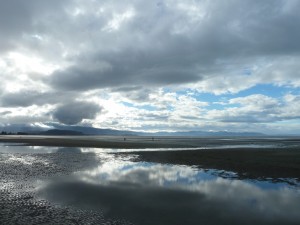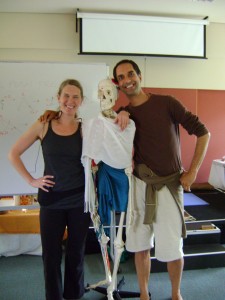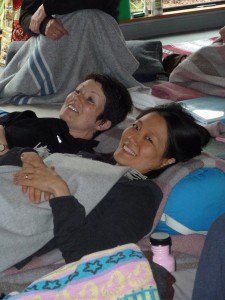I am in love with New Zealand ! The hills look as if they are made of golden velvet, the wines are divine, and the staff at the i-sites jump through burning hoops backwards to make sure their tourists have a good time. Then there’s the wildlife; whether it’s dolphins turning to make eye contact, manta rays launching themselves over the canoe, flirtatious alpine parrots (yes, parrots that live on glaciers), whale showing off their tails, seals basking in the rock pools, or shy kiwis, nature abounds in plenty.
New Zealand is where the Planetary Design Committee decided to pull out all the stops, get away as far as possible and fill the land and seas with everything possibly imaginable.
 My yoga teacher of a decade had invited me to co-lead a teacher training in Christchurch. Donna is a world renowned teacher and author with 4 books to her name and 25 years of leading seminal work in the field of Yoga, Somatics and movement therapy. I was delighted and truly honoured to be asked to work alongside a leader of her calibre.
My yoga teacher of a decade had invited me to co-lead a teacher training in Christchurch. Donna is a world renowned teacher and author with 4 books to her name and 25 years of leading seminal work in the field of Yoga, Somatics and movement therapy. I was delighted and truly honoured to be asked to work alongside a leader of her calibre.
Our group consisted of 3 lead-teachers, 8 assistants and 50 students from all over the world. There was a good dose of locals whose practical good sense and resilient nature shone through, especially as story after story of the earthquakes unfolded. The aftershocks continued to ripple through the ground and the buildings waking us up at night as if we were on a moving boat and not dry land.
The training is among the most highly refined work I know in the Yoga world. Part of my job was to take seemingly complex patterns, break them down into bite size intelligible pieces, and then give people an experience to anchor that learning. I love doing this! It’s something I have had to train consistently when clients who have zero body awareness walk in to the Somatics Clinic looking for answers to their pain.
 Donna’s training is based on 8 patterns, called Developmental Movement Patterns which in turn were pioneered by another of my teachers Bonnie Bainbridge Cohen. Simply put, these patterns describe the ways the body-mind organises itself in order to get from fetus to feet. We would n’t be able to walk, crawl, jump or co-ordinate everyday movement without a blueprint to help. Imagine coordinating 10,000 workers to do a single job. That is exactly what the brain has to do on a biomechanical level everytime we do something as simple as making a cup of tea.
Donna’s training is based on 8 patterns, called Developmental Movement Patterns which in turn were pioneered by another of my teachers Bonnie Bainbridge Cohen. Simply put, these patterns describe the ways the body-mind organises itself in order to get from fetus to feet. We would n’t be able to walk, crawl, jump or co-ordinate everyday movement without a blueprint to help. Imagine coordinating 10,000 workers to do a single job. That is exactly what the brain has to do on a biomechanical level everytime we do something as simple as making a cup of tea.
Patterning is such an obvious and natural process that it goes unnoticed most of the time. We all pattern and we do it mentally and emotionally as well as physically. It is easier to organise feelings and thoughts into related compartments rather than create a new construct everyday. We would be overwhelmed by the sheer volume of information to process otherwise.
So, what happens then when we get stuck in a pattern? In Yogic philosophy we call this a samskara (from 2 Sanscrit word roots that mean ‘to flow together’). A samskara is a groove in the mind that makes thoughts flow the same direction just like a groove in a record that keeps playing the same old tune. Buddhist psychology speaks of samskaras as imprints in the mind that have a life of their own. Unchecked, they become addictions. Holding patterns usually lead to pain of some kind, especially if they are patterns we have outgrown. In other words, we think we’ve moved on but the body-mind has n’t followed.
Whether I am breaking down Trikonasana (Triangle Pose) for a yoga student, coaching a professional cyclist to use his legs in a different way, or teaching a new mum how to hold her baby properly, I am essentially applying the same principle. What pattern is most prevalent and is it serving that person?
 There are many doors to change, and once we open one of them, we set in motion a process capable of creating enormous growth and transformation. That is what each of the students in New Zealand did on the training. I wish them well with their journey and was deeply honoured to be able to open some doors for them.
There are many doors to change, and once we open one of them, we set in motion a process capable of creating enormous growth and transformation. That is what each of the students in New Zealand did on the training. I wish them well with their journey and was deeply honoured to be able to open some doors for them.
Donna, Neal Ghosal and I will teach the next Developmental Teacher Training in Seattle in July 2013. I can only hope Seattle’s parrots are as flirtatious and the mantas just as joyful.
Namaste.
Lisa Petersen,
Dublin, February 2012
